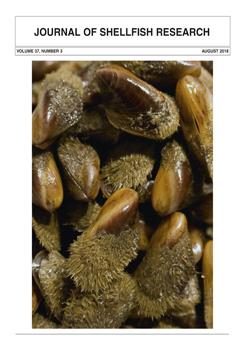Many decapod crustaceans inhabiting estuarine and coastal shores with larvae that develop in the coastal ocean release them at nocturnal ebb tides in a semilunar or lunar spring tide cycle under semidiurnal tidal regimes. In common brachyurans on warm temperate shores, this release cycle becomes first established in their mid-reproductive season. How this occurs is poorly understood, under the dichotomous views that peak larval release in each spring tide during the mid- to late season is timed to the syzygy date or the date with the largest tidal range (TR) and fastest tidal currents a few days later. The callianassid shrimp, Nihonotrypaea harmandi, inhabiting an intertidal sandflat in midwestern Kyushu, Japan, under a mixed, mainly semidiurnal, tidal regime has a reproductive season from June through October at water temperatures ranging from 20°C to 29°C. Frequent population sampling was conducted in 1993 (to mid-August) and 1994 (to early November), with cold and hot summers, respectively. Observations and experiments on embryo deposition and larval release, and measurement on water level and velocity were performed in other years. Harmonic analysis of tides was made on the water level and velocity and applied to those in 1994. Female shrimp released larvae at nocturnal ebb tides. The population comprised three age cohorts (one 2-y-old and two 1-y-old), and eight distinct larval releases occurred during June to October, each forming a batch preceded by embryo deposition by 3 wk to 2 wk linked to 20°C to ≥ 25°C in water temperature, respectively. Syzygy-centered peak embryo deposition first occurred in late July (for the third batch in 1994) and early August (for the fourth batch in 1993), with each batch dominated by the youngest cohort. Afterward, peak larval release immediately followed by peak embryo re-deposition every spring tide occurred in 1994. In the earlier reproductive season, the older two cohorts were dominant in the mature individuals, with a longer longevity of the oldest and more dominance of the second oldest in 1993 than in 1994, and embryo deposition was only weakly synchronized with syzygies, followed by longer embryo developmental durations. The peak larval release dates for the first two (in 1994) or three (in 1993) batches were between neap and spring tides. Thereafter, the peak date for each batch approached the largest-TR date but never coincided precisely. Seaward larval transport efficiency evaluated by the product of mean water velocity per ebb and ebb duration suggests suboptimal values throughout the reproductive season.
How to translate text using browser tools
1 August 2018
Normal Delayed Establishment of a Semilunar Brooding and Larval Release Cycle in the Course of the Reproductive Season of the Ghost Shrimp Population on a Warm Temperate Intertidal Sandflat
Akio Tamaki,
Jun-Ichi Itoh,
Yuichiro Hongo,
Seiji Takeuchi,
Tetsutaro Takikawa
ACCESS THE FULL ARTICLE

Journal of Shellfish Research
Vol. 37 • No. 3
August 2018
Vol. 37 • No. 3
August 2018
embryo brooding Duration
embryo deposition
larval export type
Nihonotrypaea harmandi
semilunar rhythm
syzygy




